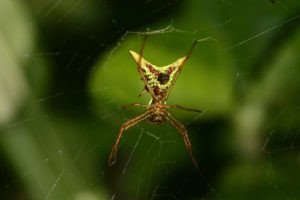Spiders have been at the heart of nightmares since humans could dream. For some, one is too many, but others may have a higher tolerance. Regardless of the starting level, an increase in activity can be a cause for concern. These surges in appearances will lead to the question, “Why do I have an increase in spider problems?”
Prey
The number one underlying contributor to an increase in spider problems is an increase in their prey. Spiders feed on insects, so more insects mean more spiders can live happily. Understanding what food source is driving the spider population can be a key to creating an effective plan at reducing the spiders.
Light
In some situations, it isn’t necessarily that insect populations have increased, but simply concentrated their location somewhere that is drawing the spiders in. Exterior lighting either such as porch lights or even light from the inside flowing out through a window can draw insects toward it. Spiders will quickly pick up on the trend and build some webs to capture their next snack.
Moisture
Most pests that spiders feed on are moisture dependent. Anywhere that collects water is likely to become a breeding ground for insects which will draw spiders into the area. Moisture may collect as:
- direct water (ponds, birdbaths, tree holes, upside-down bottle caps, pet dishes, etc.)
- water soaked materials (mud, wet boxes, wet wood, etc.)
- humid air (damp crawl spaces, humid basements, cooking exhaust areas, etc.)
Disturbance
In some cases, spider population spikes may come from disturbing nesting areas. This could be a large population of spiders in a shed that gets knocked down. This could also be other insects that lose their nesting site, migrate your direction, and attract spiders in.
The disturbance could be by you on your property or a neighboring property. In some cases, it could even be natural disturbances such as changes in water levels, felled trees, etc. If the amount of spider activity increases, look for what changed in the environment in or around the area.
Hatching
In some cases, spiders will simply increase because of a bunch of eggs hatch. Some spider species lay as few as 2 eggs at once, but others may lay 1,000 eggs. When those hatchlings come out, they will be looking for their own places to shack up and get feeding. Some spider species will even travel significant distances after hatching by spinning a silk wind sail that will carry them wherever the wind is blowing that day.
Reducing the Spider Count
Once you know which portion of the spider equation changed in their favor, you can simply undo it to get things back to normal. If there are too many spider snacks running around, reducing that population will trickle down to the spider population. If the light is bringing in excessive flying insects, switching to yellow CFLs or covering windows. If moisture is the issue, improving drainage or dehumidification can turn the tables. In cases of disturbances and hatchings, either time or direct arachnid control efforts are the answer.
If you need help identifying the cause of the spider spike, reach out to the spider experts at Rove Pest Control for the fastest solution. Rove technicians are ready and able to take the spider woes off of your hands and return life to its normal working order – guaranteed.

